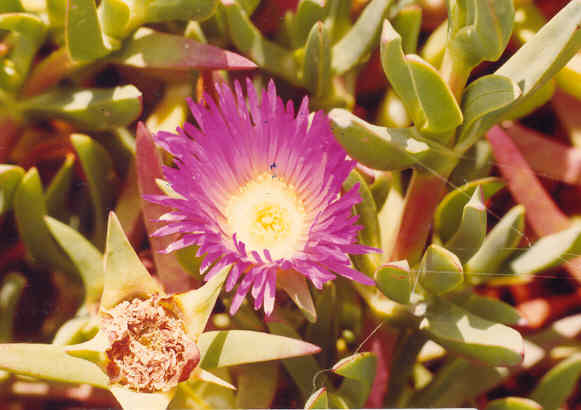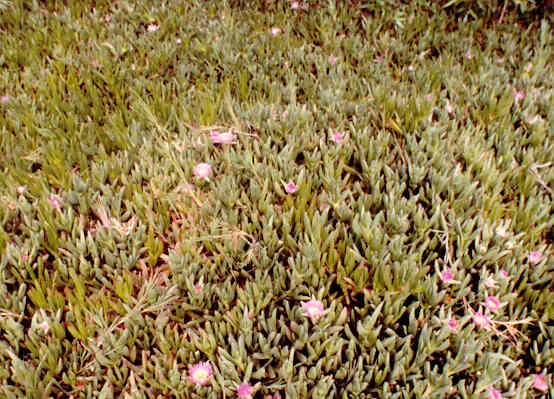
 |
Carpobrotus chilensis (Molina) N.E. Br.Mesembryanthemum chilenseCarpobrotus aequilaterusAizoaceae (Carpetweed Family)South AfricaSea fig |
June Photo
Plant Characteristics:
Subshrub with long, 2-angled, prostrate stout branches 1 m. or so long,
forming extensive mats; lvs. 3-5 cm. long, opposite, united at base, straight,
saber-shaped, 3-angled, not serrate; fls. terminal, sessile or short-peduncled,
3-5 cm. broad; fl.-tube turbinate, 2-3 cm. long; sepals unequal, the larger
foliaceous; petals rose-magenta; ovary 8-10-loculed; fr. fleshy indehiscent;
seeds obovoid, somewhat compressed.
Habitat:
Sand dunes and bluffs along the coast; Coastal Strand, Coastal Sage
Scrub, etc.; L. Calif. to Ore.; Chile. April-Sept.
Name:
Carpobrotus comes from the
Greek words meaning edible fruit. The
species name refers to the equal sides of the leaves.
(Dale 38). Chilensis, belonging to Chili.
(Bailey 12).
General:
Occasional in the study area. Photographs
are from Santa Ana Heights and Back Bay Dr. near the old Salt Works dike. (my
comments). Both
C. aequilaterus and C.
edulis have been used extensively for erosion control on banks.
Actually, they are shallow-rooted and give way readily to heavy rain.
(Dale 38). Delfina Cuero, a Kumeyaay
or Southern Diegueno Indian, made the following comment about Carpobrotus
chilensis in her autobiography: "We
ate the fruit fresh; leaves were as a vegetable; seed was ground for
pinole." (Shipek 93).
The Kashaya Pomo Indians of northern California ate the fruit of C.
chilensis after gathering it from coastal sand dunes.
(Campbell 136). About
25 species, largely of the Southern Hemisphere.
(Munz, Flora So. Calif. 56).
C. aequilaterus misapplied to Carpobrotus.
(Hickman, Ed. 128).
Text Ref:
Hickman, Ed. 128; Munz, Calif.
Flora 309; Munz, Flora So. Calif.
56; Roberts 6.
Photo Ref:
June 7 83 # 19A, 20A.
Identity: by R. De Ruff,
confirmed by F. Roberts.
Computer Ref: Plant Data 117.
No plant specimen.
Last edit 10/17/02.
 |
April Photo